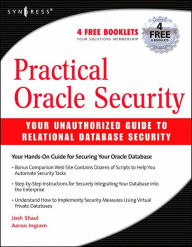The authors begin by defining three levels of Oracle security -- basic, best practice, and lockdown -- and helping you decide where each of your databases fits. With that framework in place, you can move on to installation and post-install configuration, then to securing default accounts and passwords. You'll learn how to determine which of the thousands of combinations of default credentials will get a hacker into your versions of Oracle, close down each of those hidden entryways, and make sure the passwords you do use actually resist attack.
Next, you'll turn to file permissions. The authors identify key files whose protection deserves special care, and discuss issues ranging from backup files to managing file changes. The book also contains a full chapter on patch sets, coverage of security metrics, and much more.
Throughout, the discussion is relentlessly realistic. And the book's sidebar features are especially valuable -- from "Tools & Traps" sections to end-of-chapter FAQs. ("How much work is involved in securing an Oracle database?" "How often should I scan my databases for default passwords?" "I've implemented encryption, but where do I store the private key?") If you’re not wondering about the answers to questions like these, one of your colleagues probably is. Bill Camarda, from the November 2007 Read Only
